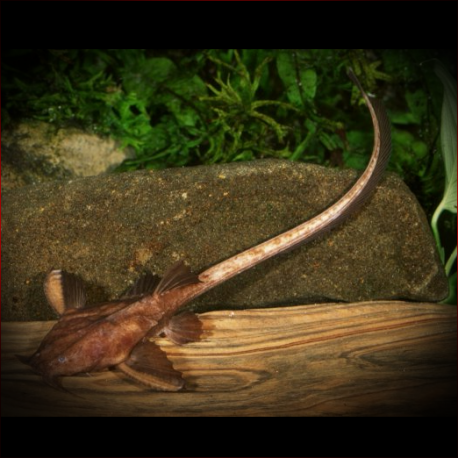More info
Datasheet
| Minimum Tank Size | 110 litres / 29.06 US gallons |
| Maximum Size | 32.0cm / 12.60inches |
| Temperature | 22°C / 71.60°F - 25°C / 77.00°F |
| Hardness | 12-30ºdH |
| pH | 6.0-8.2 |
General Description
The Banded Banjo Catfish, scientifically known as Platystacus Cotylephorus, is a unique and intriguing aquarium species. It is characterized by its inactive and secretive nature, often resembling a dead leaf and displaying remarkable camouflage abilities. This catfish has a sedentary lifestyle, mainly active during the night and preferring to drift in the water current rather than swim actively.
Aquarium Setup
To create a suitable habitat for the Banded Banjo Catfish, a tank size of at least 110 liters is recommended. The setup should include hiding spots, dim lighting, a sandy substrate for burrowing, and decorations like bogwood, branches, smooth rocks, and non-toxic dried leaves to mimic its natural environment. While not mandatory, maintaining brackish conditions is possible but not necessary for this species. Water parameters should be within a pH range of 6.0-8.2, hardness between 12-30 dH, and temperature kept at 22-25°C.
Behaviour
This catfish species is peaceful with tankmates larger than its size that share similar water conditions. It may eat small fish but generally coexists well with livebearers, Central American cichlids, rainbowfish, archerfish, scats, monos, gobies, and chromides. The Banded Banjo Catfish is notably peaceful towards its own kind and can be housed singly or in groups within the aquarium.
Feeding and Diet
Feeding the Banded Banjo Catfish can be challenging due to its sedentary lifestyle. It enjoys a diet of live and frozen foods like bloodworms and earthworms, sinking dried foods, and should be fed after lights out to ensure it receives an adequate share of food.
Reproduction & Dimorphism
Reproduction of the Banded Banjo Catfish has not been extensively observed in aquarium settings. However, reports suggest that they spawn in brackish water and may migrate to freshwater during breeding. Females develop cotylephores on their bellies to support the eggs, indicating a unique form of brood care. Males are darker and more patterned than females, with mature males developing enlarged pectoral fins.
Habitat and Distribution
Native to regions including French Guiana, Guyana, Suriname, Venezuela, Brazil, Trinidad, and Tobago, the Banded Banjo Catfish inhabits estuarine and coastal waters. It is commonly found in silty mangroves, preferring muddy substrates where it can bury itself for camouflage and protection.

